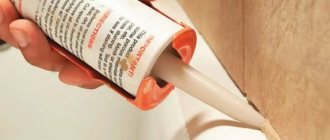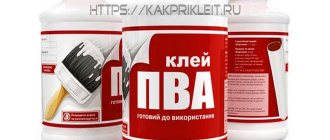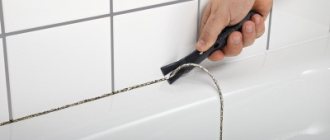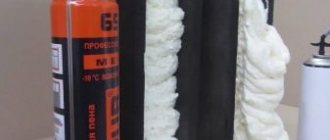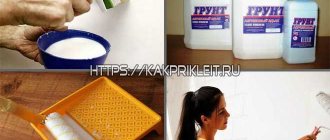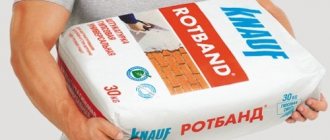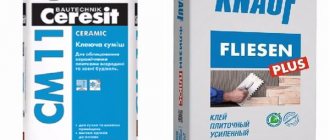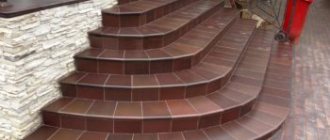Sealants have become firmly established in construction and repair practice due to their versatility, reliability and ease of use. The main disadvantage is that silicone sealant takes a long time to dry: from 15 to 24 hours. The curing time of the applied composition can vary significantly depending on drying conditions. Let's figure out what determines the drying time of the sealant and how to speed up this process.
How long does silicone sealant take to dry?
If there is any crumbling material on the surface, it must be removed with a spatula and the surface sanded, then remove all dirt using a vacuum cleaner.
It is also worth ridding the surface of moisture; for this you will need a solvent or alcohol, which must be applied to the surface with a soft cloth. To make your task easier, you can use masking tape, which must be glued on both sides of the future seam, leaving a strip of free space between them. Once the sealant is applied, you simply remove the tape. Before you apply tape, you need to know exactly how thick the seam should be. And when applying, make sure that the length of the sealant seam does not exceed the length of the glued strips of adhesive tape.
How to use sealant in a gun?
How to properly install sealant into a gun? First you should cut off the cartridge, keeping in mind that the more you cut, the thicker the seam will be. If a conventional skeletal tool is used to apply the material, then to install the cartridge you must first press the lever at the top and pull out the piston, and only after that can you install the can.
To ensure maximum straightness of the line, the gun should be held to the seam at an angle of 45°. To release material from the pipe, the trigger of the gun must be pulled smoothly. When applying sealant, you must slowly move the gun towards you without breaking the line. After the line ends, you must release the trigger and then press the locking lever. Upon completion of all sealing work, you need to put a special cap on the pipe spout, which will protect the sealant located in the cylinder from drying out.
After applying the material, the resulting seam should be lightly sprinkled with soapy water and formed using a spatula. Only then can you remove the masking tape.
How long does silicone sealant take to dry?
The time it takes for the seam to dry completely depends on the conditions, namely the ambient temperature.
Stages of this process:
- In general, surface drying, that is, the formation of a non-sticky film, occurs in approximately 15-20 minutes; the manufacturer in most cases indicates the exact data on the packaging;
- Partial (in some places) hardening occurs after 3 hours; if the layer is thin, the sealant can harden completely;
- At room temperature, complete hardening is achieved within 24 hours. If the seam is deep enough and has a considerable width, then the process may take longer.
After final drying for a week, the strength of the seam further increases, so it is recommended to leave it for a longer time.
This process can be speeded up by ventilating the room.
We have discussed the question of how long it takes for silicone sealant to dry, but it is worth recalling that the presented indicators do not apply to all sealants. Sometimes it takes up to 4 weeks for the silicone mortar mixture to harden completely, for example, when using a mixture for parquet.
How to speed up polymerization?
Professional installers know several tricks to speed up the polymerization of the sealant. Here are some of the easiest to implement methods:
- Ensure maximum ventilation of the premises. On fine days, open the windows wide; on cloudy and rainy days, use fans. But it is important to ensure that dust does not settle on the sealant.
- Heat the air in the room to a temperature close to the maximum (+40°C). An electric heater is suitable for this. But you shouldn’t warm up the joint with a hairdryer. The heating will be uneven, so different parts of the mass will harden at different rates. This will negatively affect the reliability of the seam.
- Spray the joint with a spray bottle from time to time. Moisturizing will speed up the curing process.
- If you need to seal the seams on the window frame, you will have to dry the compound with the windows closed. To prevent the frames from sticking together tightly, after application the composition is covered with foil. The paste will take 2-4 minutes to dry, but to achieve optimal results you can only wait patiently.
These simple methods will help reduce the curing time of the sealant by several hours. Every hour you gain will allow you to complete your work faster and begin enjoying the fruits of your labor.
Features of the material
Silicone insulating material, depending on the course of the vulcanization process, comes in two types: acidic and neutral. The acidic composition polymerizes to release acid, which is included in the solution as a solvent. Such a composition can destroy amalgam or non-ferrous metal coatings.
The acidic type of mixture is suitable for:
- Installation and insulation of plastic pipes in the bathroom and shower.
- Sealing connections between sinks, bathtubs, shower trays and water supply pipes.
- Closing joints between wooden and plastic structures.
- Installation of double-glazed windows and doors.
- Protection of threaded connections and pipes from mold and rotting.
A neutral solution (sanitary) creates an elastic seam that can withstand vibration loads, pressure and temperature changes.
- For treating and insulating joints of bathtub bowls, sinks, shower trays and tiles.
- Waterproofing and sealing heating systems.
- Repair and installation of metal plumbing communications in the kitchen and bathroom.
- Restoration and filling of gaps in natural stone finishing.
- Insulation of cables when laying electrical networks.
- Protection of parts from rot and mold.
Silicone mixtures are used in the engineering industry to join plastic elements.
Non-curing sealants
These materials retain elastic-plastic properties throughout their entire service life. They are used to seal seams between relatively movable structures, such as roofing panels or large blocks. Temperature deformations are compensated by the width of the gaps from 10 to 30 mm, while the sealant ensures the tightness of the joints.
The service life of non-hardening compounds is short, only 6-8 years. After the expiration of the period, repairs are necessary by filling the seams with new mastic.
Sealants are produced in the form of cords, tapes, briquettes or unshaped masses. Packaging made of plastic film or siliconized paper is removed before use. Installation is carried out using a screw gun-electric sealer.
Types and characteristics
The basis of silicone sealant is rubber.
In addition to this, it contains:
- plasticizer – a substance that gives the sealant plasticity;
- vulcanizer - an element that changes the state of the sealant from a paste-like version to one similar to rubber;
- amplifier - responsible for the viscosity of the composition and its strength characteristics;
- adhesion primer – promotes ideal adhesion of the sealant to the materials being processed;
- filler - turns a colorless composition into a colored one (not available in all types of sealant).
All sealants, according to the nature of their use, are divided into one- and two-component ones. The former are used directly; their stable state is formed under normal conditions under the influence of moisture and air. And in order for two-component types to harden, an additional substance is required to act as a catalyst.
Based on their composition, silicone-based adhesives are divided into three types.
- Vinegar sealant. Contraindicated for concrete and metal products. The material emits acetic acid, which can cause significant harm to the metal and cause corrosion. Used when working with plastic, wood and ceramics.
- Neutral (or universal) sealant. It is marked on the packaging in the form of the Latin letter N. Suitable for all types of materials. The transparent composition is resistant to water, adheres well to metal, and can be used for aquariums.
- Sanitary sealant. Fully lives up to its name. Its purpose is the plumbing range of operations. Everything that needs to be sealed in the bathroom can be done with just such a product. Waterproof sanitary sealant does not collapse under the influence of cold and hot water, and is resistant to temperature changes and ultraviolet radiation. But its main property is its resistance to cleaning agents and detergents, which housewives love to use to keep their bathrooms and kitchens clean.
The sealant may be white, colorless or colored. The color of the paste-like substance is given by the filler.
Colored sealants can be divided into three types according to application:
- construction;
- automobile;
- special.
What is sealant
This is a viscous or paste-like mass based on polymers, which is applied to various connections to prevent leakage or penetration of moisture and air. Despite the existence of different types of sealants in composition, the most popular and in demand everywhere are silicone. They are based on artificial rubber (silicone) and contain additional substances:
- plasticizers – increase elasticity,
- vulcanizers - responsible for curing the composition,
- fillers – optimize the properties of the material, including adhesion.
Silicone sealants cure at room temperature. Thanks to their special texture, they easily fill cracks, crevices, and microdamages. Sealants are moisture resistant and can withstand temperature changes, so they are widely used for waterproofing various rooms.
Kinds
There are several varieties of caulk, each designed to work on a specific area.
Acrylic. Such sealants belong to the category of the most affordable materials, since they can only be used for interior work. The material is not resistant to precipitation, temperature changes and is not able to withstand mechanical loads. However, such sealants demonstrate excellent adhesion to materials with a porous surface. It can be used to work with wood, brick, concrete, foam concrete, aerated concrete, plasterboard and plaster. Based on the quality of the mixture, it can be used when installing wooden baseboards, doorways, and also during flooring.
Polyurethane. This material is an elastic mixture with adhesive properties, which is characterized by an increased level of adhesion to metal, stone, ceramic, plastic, wood and concrete surfaces. Craftsmen use this type for external and internal work. The mixture is not afraid of temperature changes, as well as exposure to precipitation. It is highly resistant to corrosion and can be painted.
Thiokol. It is characterized by high resistance to solvents, acids, alkalis, gasoline, kerosene and other oil lubricants. The mixture can withstand exposure to precipitation and is also able to withstand temperatures from -500 to +1300 degrees. Due to its special qualities, the sealant is used for activities with objects that require the exclusion of contact with various substances of chemical origin.
Bituminous. This material is often used during construction work. It has high-quality adhesion to surfaces made of foam concrete, brick, metal, wood and other roofing materials for waterproofing. When choosing a bitumen sealant, keep in mind that it is not resistant to elevated temperatures and takes on a liquid form.
There are two types of silicone sealant:
- acid;
- neutral.
Acidic products are not suitable for working on metal objects because the ingredient list contains acetic acid, which can cause corrosion. It is also not recommended to use this type of material when sealing cement objects.
The neutral mixture is considered universal. It is used in various fields. It can be used to seal a car engine and mirrors. The material also has another name – glass sealant. There are heat-resistant varieties on sale that can withstand up to +4000 degrees.
If the silicone sealant contains fungicides, the material is called “sanitary” or “plumbing”. It is able to prevent the appearance of fungi, so it is actively used when working in the bathroom, kitchen and swimming pools. This is the best joint sealant that can make your shower room as airtight as it was at the time of purchase.
Positive sides
Before moving on to the main issue, let’s determine why silicone sealant is used for installation work.
It has a number of undeniable positive characteristics:
- resistant to weather conditions (this is the reason why it can be used for both interior and exterior work);
- not afraid of moisture;
- resistant to chemicals;
- has high adhesion rates;
- tolerates high and low temperatures;
- UV resistant;
- has a long service life.
Selection of compositions
So, now that we have found out in what areas this material is used and for what reasons, let's move on to the main question: how long does silicone sealant harden?
Kinds
Silicone sealant is used for external and internal work. It is indispensable for the installation of plumbing fixtures and kitchen furniture. In rooms with high levels of humidity, it is recommended to use a neutral sanitary composition, which does an excellent job of sealing seams around the shower stall, washbasin or glassware. You can prevent the blowing of wooden window frames by using this product intended for external sealing. Such products do not deteriorate when exposed to sunlight and can withstand different temperatures. The colorless composition will be invisible on dark types of wood.
Among the range of these products there are special heat-resistant compounds that operate in the temperature range from -50 to +300 degrees. The product is used in electrical installation work and in the assembly of industrial structures. For roofing work, there is a bitumen-based sealant; it perfectly seals cracks and other types of defects that can form on the roof, base or foundation of a building. The product is frost-resistant and bonds well to metals, plastic and wood.
Products are divided into two groups: two-component and one-component sealants, differing in their scope of application.
Single-component products are classified depending on the base.
- Alkaline - the composition is produced on the basis of amines. This type is a specialized material.
- Acidic compounds, where the main component is acetic acid. Its smell is present as the sealant hardens on the surface. The main disadvantage of the product is considered to be incompatibility with a number of metals, since it provokes corrosion. It is not recommended to work with sealant on cement surfaces that contain alkali.
- Neutral products combine well with all surfaces thanks to the ketoxime or alcohol included in the composition.
When purchasing a product, you should pay attention to the presence of additives - this can be a dye, mechanical fillers that ensure adhesion of the substance to the base, extenders that reduce viscosity, and fungicides that protect against the development of fungus and mold. The presence of such components greatly expands the scope of product use.
The composition stretches perfectly, due to which it can be used on moving elements.
Having a number of advantages, the disadvantages of the product include minimal adhesion to narrow polypropylene plastics, fluoroplastic and polyethylene.
Since the area of use of products is very diverse, types of sealants are divided according to their application.
Special formulations are products designed to work in conditions of maximum humidity. Special sealants have good adhesion to non-uniform surfaces and also withstand contact with aggressive cleaning agents.
Scope of application
Silicone-based products are considered universal, therefore they are used to protect and seal completely different surfaces and structures. Most compounds are suitable for both exterior and interior use, although some are recommended only for indoor use. Silicone is especially suitable for the bathroom for sealing seams between the bathtub, shower stall, sink and wall or for installing plumbing fixtures.
Sealants have other applications:
- assembly of products from plastic, metal,
- various works in mechanical engineering, machine tool building,
- construction, major and cosmetic repairs,
- sealing cracks when installing windows, doors,
- gluing tiles, stone blocks,
- different installation steps,
- strengthening of mirrors,
- work with sewerage and water pipes,
- installation of electrical wiring.
Types of Silicone Sanitary Sealants
Absolutely any bathroom sealant is a mixture that contains a hardener, polymer, filler, dye and other components
When choosing this product, you should immediately pay attention to the type of polymer included in its composition. There are several types of them:
- Silicone sanitary. This is a popular and expensive material. It has strong surface adhesion to many materials, making it suitable for any work in the bathroom. It is not afraid of moisture, ultraviolet radiation, can easily withstand high and low temperatures, and has a long service life.
- Acrylic. In terms of service life it is not much inferior to silicone, it also has good adhesion, but the price is much cheaper. Resistant to ultraviolet radiation, elastic, withstands from -25 to +80 degrees. But it is better not to use it to seal joints that are subject to deformation.
- Silicone-acrylic. This type is considered a hybrid, which has absorbed all the best properties of two types of sealant - long service life and strength. Can be used as an adhesive to join surfaces.
- Polyurethane. Resistant to mechanical damage and elastic. Often used to replace seams, including silicone ones.
Thus, the market offers a wide range of silicone sealants for various purposes. Let us take a closer look at the most popular brands from well-known manufacturers for successfully carrying out repair work in rooms with excessive moisture.
Popular brands of silicone sealants
Among the huge variety of seals, such brands are especially popular.
- Moment Germent is an affordable and reliable silicone sealant recommended for sealing seams and joints. It contains added components that prevent the formation of fungus and mold. This is a fairly flexible material that is easy to apply and dries in a short time.
- Ceresit CS 25 is a heat-resistant and water-resistant sanitary sealant. The main component is silicone. A unique additive in the composition slows down the appearance of mold and fungi in places with high moisture levels. This hermetic composition has high adhesive properties in relation to various coatings: glass, porcelain, ceramics. It will become a reliable means of ensuring high-quality sealing of seams.
- Tangit S 400 is another acetate sealant based on silicone. It contains fungicides that prevent the formation of mold and the proliferation of harmful bacteria. The substance is characterized by high elasticity, good adhesion and resistance to high humidity.
It is important to note that these types of seals have appeared on the market for quite a long time. During this time, the brands reviewed have already proven themselves to be reliable products and have managed to gain the trust of consumers
Types of silicone-based sealants
Silicone sealants come in two types: neutral and acidic. Neutral (also called sanitary) is resistant to high temperatures, so it is more often used to repair heating system pipes, in plumbing work, and in kitchen and bathroom renovations. It contains alcohol and ketoxime, which give it antifungal properties.
Acid sealants also contain antifungal components. Often this is acetic acid. The main problem with acid sealants is that they cannot be used on metal, marble and cement-containing surfaces. But it glues wood, plastic and ceramics perfectly. When it gets on wooden surfaces, such a substance penetrates deep into the material and creates additional protection.
How long does it take for the composition to dry?
Gradually we came to the main question: how long does silicone sealant dry? The period of its hardening very much depends on the area of application and the composition of the product itself.
Sealant polymerization time depending on type:
- Acid-based sealant takes approximately 4-6 hours to dry.
- For neutral silicone sealant to completely dry, it takes more time, about 24 hours. In addition, an important condition is positive temperature - from 5 to 40 degrees.
Depending on the area of use, the drying time of the sealant may be as follows:
- If you apply this material generously enough, its outer layer hardens and does not stick to your hands after 15 minutes. And in the inner layers at this time the polymerization process is just starting. It passes at such a speed: every 2 mm of the inner layer hardens in 24 hours.
- If the temperature in the room increases significantly, the sealant will dry twice as fast. And if you carry out outdoor work in the cold season, then the sealant should be given more time to dry.
Sealant in the bathroom
How long does it take for sealant to dry in high humidity conditions in the bathroom? Again, this depends on the choice of product itself:
- Silicone acid sealants dry the fastest - in 4-6 hours. But such material cannot be used to work with metal structural elements to avoid corrosion of the metal.
- Neutral sealant is more versatile, but it also costs more.
Its 2 mm thick layer dries completely within a day, but the temperature should only be above zero. The most favorable range: from 5 to 40 degrees. Applying sealant to joints in the bathroom - Sanitary neutral sealant is often used in the bathroom. It contains fungicides that prevent the formation of mold on treated surfaces.
- When you seal the seam between the bathtub and the wall to which it is adjacent, the layer usually required is quite thick and wide. The time indicated on the packaging may not be enough to completely polymerize such a thickness. Craftsmen who install plumbing, as a rule, give it not 24 hours, but a little more. Most often - 2 days.
This is interesting: FineВer siding - review of the material
Time of initial drying and complete curing
It is impossible to accurately predict drying time, since in each specific case there are nuances associated with temperature, humidity in the room, layer thickness and other parameters. However, based on the experience of builders and repairmen, we can roughly say how long you will need to wait before starting to work with the frozen mass.
| Type of sealant | Application Feature | Application conditions | Drying time | Properties |
| Silicone They are transparent and colorless, are not painted on, and provide an elastic seam. Resistant to moisture and temperature changes | Universal | On any surface | The top layer “sets” in 5...30 minutes. Subsequently, it dries 2 mm per day (on average). Fast-drying varieties can completely cure in 6–8 hours | Often acidic, can be corrosive to metal and concrete, and has a characteristic vinegar odor |
| Sanitary | For wet surfaces, including water communications | Contains additives to prevent the growth of mold and mildew, usually without acidic components | ||
| Heat resistant (silicate) | For areas with elevated (up to 1200 degrees) temperatures | Contains glass silicates | ||
| Auto repair | Work in difficult conditions - with vibration, heat, exposure to active substances | Neutral, with increased elasticity and resistance to dynamic loads | ||
| Siliconized (acrylolatex) Resistant to moisture, gives a dense and elastic seam | To be painted | Sealing in damp and dry areas | Initial setting 60 min, complete drying 1 mm/day | Apply to dry surfaces |
| Acrylic Good adhesion, resistant to low temperatures, does not withstand deformation and dynamic load | Waterproof | Versatile | Full cure within 12 hours under favorable conditions. In unfavorable cases – up to 1 month | Not afraid of water, but applied only to a dry surface |
| Not waterproof | Used for repairing furniture and wooden products | Apply only to dry surfaces, dissolve with water | ||
| Bituminous Water resistant, excellent adhesion | Bitumen-polymer | For external work, roof waterproofing, gluing coatings | Full cure in 14…21 days | Apply to dry surfaces (preferably), at above-zero temperatures, often heated |
| Bitumen-rubber | The surface film hardens in an hour, the time for complete drying depends on the thickness of the layer and conditions | |||
| Polyurethane High adhesion, elasticity, strength, durability up to 20 years | Visually and in characteristics similar to polyurethane foam | Caustic composition, used for outdoor work | Initial setting 15...30 minutes, full curing 12...24 hours | Apply to a dry, grease-free surface |
Important: the table shows approximate (average) data for each type of sealant. For specific products, it is necessary to clarify the data.
Drying time for silicone sealant
How long the material takes to dry depends on its type and place of application:
How long does it take for sealant to dry in a bathroom?
Special types are used in wet rooms
sealing silicone. Each of them has its own drying time:
- A universal neutral material with a 2 cm layer in the bathroom will dry in 24 hours. The air temperature in the room should be at least +5 C and no more than +40 C.
- The acidic composition dries the fastest in humid conditions. 4 to 6 hours are enough for him. But it is not recommended for use on metal products, as corrosion of the metal may occur.
- When sealing the gap between the wall and the bathtub, a wide, thick layer is obtained. Therefore, the seam will harden for 24 hours, and not less than two days. All its inner layers should dry well.
If a situation arises
, in which it is necessary to speed up the drying process of the material, this can be done in the following ways:
- create maximum ventilation by opening all windows and doors in the warm season;
- increase the air temperature in the room to +40 C;
- speed up the drying process by spraying the seams with water (silicone that is wet on top will dry faster).
In the bathroom, the material is mainly used for sealing the gap between the bathtub and the wall, processing the joints of shower cabin parts
and similar works. Installation of silicone is quite simple. You just need to follow the following rules:
- Clean and dry the surfaces and edges of the bathtub or shower stall.
- Use masking tape to cover the surface areas as close to the seam as possible. In this case, the seam will be smooth, and the silicone will not stain the bathtub and walls.
- The silicone compound is filled into a special gun. To ensure that the diameter of the seam and the hole coincide, the spout of the tube with the material is cut at a certain angle.
- The tip of the gun is inserted into the joint, and the composition is carefully distributed along the seam.
- While the sealant has not set, the seam can be corrected if it is not very smooth. To do this, you can use a soapy finger or a rubber spatula.
- Once installation is complete, remove the masking tape.
A bathtub or shower can be used
after the silicone sealing material has completely hardened.
To know how long after installation
Once the silicone sealant dries, you should read the instructions when purchasing it. Manufacturers indicate the approximate drying time of the material on the packaging.
General recommendations
Considering that information can only be obtained from the data on the product packaging, you should focus on:
- the basic setting time before which the seam can be smoothed or leveled is no more than 10 minutes;
- Accordingly, the length of the seam to be filled should be such that the master has time to apply and smooth the silicone before it sets. This parameter is determined individually;
- Despite the fact that manufacturers indicate a complete curing time of 24...48 hours, you should not load the structure in which the seams were filled earlier than after 72...240 hours. The duration of the “insurance period” depends on the size of the seam; when filling large and deep cavities, the basic estimated time should be multiplied by 2…3.
Acid and neutral type of sealants
Silicone sealants come in two main types, each with different properties and different drying times:
- Acid. Easily recognized by the characteristic strong smell of vinegar. Resistant to high temperatures and ambient humidity. However, it reacts violently to the proximity of lime or other alkalis, so it cannot be used everywhere.
- Neutral. They do not have any odor. They are more resistant to external active substances, but do not tolerate high air humidity.
Now let’s look at both types in more detail, especially since they still have subspecies.
The most common type of acid silicone sealant is sanitary, also called plumbing sealant. It is not susceptible to the harmful effects of excess moisture, as well as mold and mildew. Ideal for sealing cracks in the bathroom or kitchen. Sticks firmly to glass, enamel, ceramics, brick, and most types of metal.
Also, acid silicone sealants are high-temperature (can withstand up to 280 ° C), glass (well suited for porous or smooth surfaces, resistant to ultraviolet radiation) and universal. From the name of the latter it is clear that such a product is suitable for almost any purpose. It is not recommended to use the universal type only with acrylic, polyvinyl chloride and metals that are subject to corrosion.
As for neutral sealants, they are divided into sanitary (good for sealing various building materials, but sensitive to moisture), masonry (prevent the occurrence of fungus), construction (powerfully attached to metal or plaster) and rarer types (for mirrors, for increased hygiene , aquarium, roofing).
Types of sealants
Depending on the type of curing, all silicone products are divided into two groups:
- Acidic (acetic). The composition contains acetic or other acid, so they have a characteristic pungent odor. These products cannot be used on metal, as they cause rapid rusting of the material. Also, most acid sealants can ruin marble and other types of stone and are harmful to concrete surfaces. Such products are well suited for ceramics, glass, wood, and plastic.
- Neutral. More expensive in price, but completely safe for materials and humans. The vulcanizers in them are alcohols, amines or amides. They do not emit odor, are non-toxic, and are suitable for any substrate without exception. Some compositions are even suitable for aquariums.
Separately, you should indicate a sanitary sealant - a product with the addition of fungicides (antifungal additives). Most of them have a neutral reaction, although acidic compounds are also available. It is recommended to use such products for work in the bathroom, because they prevent the growth of mold, are waterproof, and do not darken over time.
Types and characteristics
All sealants today are divided into only 2 main types:
- One-component composition. This type is sold in any hardware store and is one of the most common. Compositions of this type are sold in tubes made of metal or polyethylene. This component hardens due to the presence of moisture in the air. The main disadvantage of this type is rapid hardening, but only if the surface is treated with a thin layer. And if the layer is more than 1.2 cm, then the sealant takes a long time to harden.
- Two-component type. Such mixtures harden in any layer, but the cost of such a composition is higher, since they are mainly used for industrial purposes.
“Moment” sealants are single-component types, as they are intended for use for domestic purposes.
manufactures two types of sealants. The first type is silicone-based sealants, and the second type is made based on acrylic water dispersion.
Acrylic-based sealants are more resistant to frost and various adhesion of treated surfaces. The main disadvantage of acrylic compositions is the inability to use in an environment with constant moisture. As for the color of this sealant, it is mainly white.
Silicone sealant is made on the basis of rubber polymer. This component makes the mixture more elastic and allows it to harden in a short time, even at room temperature. Due to this characteristic, Moment silicone sealants are sold in special plastic tubes that retain its liquid and plastic state for some time after manufacture. Tubes can be produced with volumes from 85 ml to 250 ml.
If we divide the compositions based on the area of use, then they can be construction, automotive and special.
Based on their composition, they are divided into two types:
- Neutral. Instead of acetic acid, alcohol is added to the composition of such material and thus a less pungent odor is obtained. They can be used outdoors and indoors. Such mixtures are used in the field of shipbuilding, for sealing freezers; they can be transparent and white.
- Universal sealants. The production of such a composition involves the addition of a vinegar mixture, which gives an unpleasant and pungent odor, and when interacting with non-ferrous metal, cement and similar materials that contain alkalis, causes corrosion. This type of sealant is produced in white or transparent color. It can be used for internal processing, that is, indoors, and for outdoor work, as it is moisture and heat resistant. The cost of such a composition is lower than that of a neutral one.
The Henkel company also produces Moment Germent sealant; it can be used for both domestic and professional use. This sealant is divided into several types:
- Premium white, which is highly resistant to moisture and consists of silicone. This type can be called the most heat-resistant.
- The next type, which is made on the basis of silicone and sodium silicate, copes well with oil, gasoline, and high temperatures, which can reach up to 300 degrees. It dries quite quickly, and its color can even be red.
- Type of sealant Sanitary is used for the manufacture of glazing of shower stalls and bathtubs, but it cannot be used for treating stone and rusty surfaces; its hardening speed is approximately 15 minutes.
- Aquarium type, used for treating painted and glass surfaces that are subject to frequent vibrations. It is popular because it has an increased level of moisture resistance, and the color of this composition is extremely transparent.
The same series of Moment materials includes a gray sealant, which is made on the basis of polyurethane. It is often used as a grout for moving joints and as an adhesive for tiles. It is resistant to moisture, acids, alkalis, water and similar negative factors. But it has a drawback, since it fades under direct sunlight and loses its elasticity over time.
Anaerobic sealants
This type of material can be stored in a breathable container for more than a year, maintaining its properties. After application to the surface, the curing process begins, which lasts from 1 to 7 hours. Full strength is achieved after 24 hours.
The main condition for the use of anaerobic sealants is that the surfaces must be metal. When interacting with them, the liquid composition turns into a solid, colorless polymer. Anaerobic compounds are used for sealing welds, threaded and flange connections, and fixing metal parts. They are resistant to vibration, critical temperatures, aggressive environments and corrosion.
“Active” metals such as copper, iron, brass or their alloys speed up the curing of compounds. “Passive” - aluminum, silver, zinc, on the contrary, slow down. If the metal surface is passivated, the activity also decreases.
To accelerate the hardening of the sealant, treatment with organic solvents, copper salts, as well as the introduction of peroxides and some acids into the composition is used. They initiate polymerization, which can significantly reduce waiting time.
Description, characteristics, pros and cons
Any silicone sealant is necessary to create a strong and reliable insulating seam, so there are many different requirements for this product. When it is necessary to create high-quality and durable insulation of heated elements, heat-resistant silicone sealants are used, as well as materials based on other components.
Heat-resistant sealants are made from special polymer materials, which include silicone and other additives; this product has the form of a plastic paste. Additional components give the composition certain characteristics.
Typically, silicone sealants are supplied in plastic pipes; they come in two varieties. The composition is simply squeezed out of some tubes, but to use other tubes, a mounting gun is required. In addition, one-component and two-component adhesive-sealants are produced.
Heat-resistant compounds have a wide range of uses and are used in various construction, finishing, installation and repair works, since these products have excellent characteristics:
- have a high ductility index;
- heat-resistant silicone-based sealants can be used at a maximum temperature of 350 degrees;
- fireproof, non-flammable, some types of heat-resistant adhesives and sealants can withstand temperatures of +1500 degrees;
- withstand enormous loads without damage, while the sealing characteristics are not lost;
- high resistance to ultraviolet rays;
- ability to withstand both extremely high and very low temperatures, down to -50 degrees;
- excellent adhesion (adhesion) indicator, due to which heat-resistant silicone is used for application to many building materials. The main condition for good adhesion is the absolute dryness of the materials;
- waterproof, resistant to moisture, alkalis, acids and other chemical products;
- long period of use;
- safety for humans, silicone does not emit any toxic or harmful substances into the air;
- There is no need to use personal protective equipment while applying the adhesive.
Despite all the above advantages, heat-resistant sealants have some disadvantages:
- cannot be applied to wet materials, this will cause a decrease in adhesion;
- before application, the surface is thoroughly cleaned of any debris, including dust, dirt, grease stains, etc., otherwise adhesion will be significantly reduced;
- long hardening period, which is 1-2 days. If you apply silicone glue at low air temperatures and low humidity, the hardening period will be significantly increased;
- heat-resistant silicone cannot be painted, as any paint will begin to crumble after drying;
- Silicone sealants are not suitable for filling wide and deep joints. During hardening, these compounds use the moisture in the air, and if you apply a very deep seam, the silicone may not harden.
The instructions on the packaging will indicate what the maximum width and thickness of the sealed seams can be. The maximum permissible value must not be exceeded, otherwise the heat-resistant sealant will begin to crack over time.
What determines drying time?
Standard hardening conditions provide that the air temperature does not fall below +5...+10°C, and the humidity is in the range of 50-70%. With these environmental parameters, the sealant will dry approximately within the period specified by the manufacturer on the packaging.
To calculate the hardening time, not only external conditions are important, but also the thickness of the sealant layer itself. Active evaporation of the solvent or polymerization of components begins, as a rule, with the formation of a film on the outer part of the surface. Therefore, sealant packaging often indicates not the total curing time, but its speed. For example, a speed of 3 mm/day means that a layer with a thickness of 3 mm will dry completely in 24 hours, and a layer with a thickness of 6 mm will dry in 48.
To quickly start the process, it is advisable to take into account the recommended application temperature. To avoid delaying the curing period, the glue must be kept at a positive temperature for several hours and then used.
Too high a temperature (above +35-40°C) is a risk factor that causes accelerated evaporation of volatile components and a decrease in the strength of the adhesive joint. Therefore, increasing the temperature above the recommended one is not advisable, especially in critical connections.
In the cold (below +5°C), the evaporation of solvents slows down, as does the polymerization reaction. The sealant practically stops drying, and in some cases completely loses its qualities. Therefore, when storing, you must follow the manufacturers' recommendations.
How to properly seal seams in the bathroom: instructions
Silicone sanitary sealant is convenient to use for high-quality sealing of any seams in a damp room. It is sold ready for use in special cartridges that are used to fill the sealant gun.
To ensure the job is done efficiently, prepare in advance:
Now let's look at the step-by-step instructions on how to apply the sealant yourself.
- Surface preparation. The work area is cleaned of dirt and degreased.
- Application of sealant. Armed with a gun loaded with a cartridge with a sealant, carefully apply the product along the seam through a special tip. The composition should be applied by smoothly pressing a special lever located on the gun. The seam is filled with the compound to the maximum depth. If the groove is too wide, it is recommended to reduce it using foam plastic.
- Seam alignment. This manipulation is best done with a finger dipped in a solution of water and soap. Excess sealant can be easily removed with a wet cloth. You can use plumbing fixtures for their intended purpose only after the composition has completely hardened.
Next, we will consider the question of how long it will take for the silicone product to completely harden.
How to apply sealant correctly. Step-by-step instruction
Silicone-based sealants are available in 310 ml plastic tubes. Before using the sealant, it must be prepared:
- First of all, the tip of the tube is cut off.
- Next, put on the cap included in the kit.
- After this, the distributor is cut at the desired angle.
- Then the prepared sealant is inserted into a special gun. Next, it is fixed in the tool.
When starting work, you should insert the tube cap into the joint and, pressing the trigger of the gun, evenly distribute the sealant on the base being treated.
The pressing force when using the tool must be compared with the speed of its movement along the joint. This will make it possible to obtain a smooth and aesthetic seam as a result.
The sealant should not be skimped. All gap cavities must be filled. Otherwise, when the sealant hardens, cracks may appear between the base and the seal.
Often the filled joint does not turn out completely smooth. In this case, there is no need to wait until the sealant dries. You need to remove the excess and trim the seam with a moistened rubber spatula. You can also use a small plastic scraper for this. Professional builders often level the filled joint with a finger dipped in a solution of laundry soap.
How to remove from the surface
The silicone seal is elastic, but despite this, it is durable. It sticks firmly to the base. It is not easy to remove the seal from its surface. The material has to be cut by inserting a sharp knife between the interlocking surfaces. Therefore, it is necessary to work with silicone sealant carefully.
But what should you do if you still need to remove the frozen sealant from the base? When the silicone layer is quite thick, it is relatively easy to remove. It should be pryed with something and simply torn off from the base.
A different situation arises if you have to remove a thin layer or stains of carelessly applied material. They are difficult to remove, especially when you need to maintain a sealed joint.
In this case, you should carefully separate the layer to be removed from the one that needs to be preserved. To do this, you need to cut through the material in the problem area with a sharp knife, and wipe off unnecessary residues with your finger. This method is well suited for fresh sealant that has not yet reached 100% strength.
Old material is removed only with the help of chemical compounds that soften it. Manufacturers produce many cleaners that can help remove old sealant. The best ones:
- Silicone Remover. This is a universal cleaner for all surfaces.
- Sili-kill from the Dutch manufacturer Den-Braven. After using it, the silicone is simply removed with a sanitary napkin.
- Permaloid-7799. This product is intended for removing silicone sealant from metal substrates and painted surfaces.
- Permaloid-7010. It is used to remove sealant from plastic, including PVC, acrylic, polystyrene.
How long does it take for bathtub sealant to dry?
How long does it take for bathtub sealant to dry?
Every home craftsman should know how long it takes for silicone bathroom sealant to dry. It is mainly used in kitchens, baths and other non-residential premises with high humidity. One-component sealant today is the most common material for sealing various seams from the penetration of moisture, insects, dust, gluing of homogeneous or dissimilar materials, etc. Only when using sealant is guaranteed high-quality waterproofing or fastening of sides, baguettes, baseboards, etc. to the surface.
How long does it take for silicone bathroom sealant to dry?
How long does it take for bathroom sealant to dry? To answer this question, you need to understand that they are all divided into neutral and acidic. Each has its own characteristics and primary purpose. Neutral sealant is made with alcohol or its analogue (ketoxim). Some “models” contain antifungal additives. The sour smell during work comes from there. Heating pipes and radiators, drains, seams between kitchen and bathroom sinks, etc. - this is all the area of application of neutral sealant. Acidic ones are made on the basis of one or another acid. Its main purpose is gluing parts. Acid has a bad effect on metal (causes corrosion) and natural stones (the natural color fades), so such sealants cannot work on them.
Drying time
How long does it take for bathtub sealant to dry? Drying time directly depends on the composition and recommended area of application.
Acid silicone sealant usually dries within 4-6 hours from the moment of application, provided that the working surface has been prepared according to the rules (degreased, free of dirt and dust). Regular neutral sealant dries within 24 hours. A prerequisite is the absence of negative temperatures! The temperature in the room should be from 0 to 40 degrees (sweat at high temperatures is likely to damage the structure of the sealant). In principle, each manufacturer provides its recommendations on the packaging. But still, certain technical points must be taken into account:
whatever the thickness of the seam, the material is applied in one pass. Multi-layer application is unacceptable (ultimately delamination of the seams will occur),
By the way, you can order such a nozzle HERE. Many people asked, I came across it by chance
after the initial reaction, i.e. contact with air, the top “crust” forms after 15 minutes
On average - 2mm layer (thickness) per day, the joint between the bathtub, sink, sink, stove, etc. may be wide. Consequently, final hardening may take 1.5-3 times longer than stated by the manufacturer. Be patient, and if you need to check, check very carefully. External hardness can be very deceiving
By carelessly catching or pulling the edge of the strip, you run the risk of nullifying all your work (you will have to remove and reapply the sealant)
How not to speed up polymerization
When working with sealant, you need to consider that:
- Before final drying, the material is very fragile, so you should not deform it, stretch it, etc.
- During the hardening process, it is necessary to maintain the optimal temperature in the room as recommended by the manufacturer. If the temperature drops below zero, the product will not harden, and due to extreme heat, the substance may collapse.
- The sealant must be applied in one layer.
In an effort to speed up the drying process, you can make a mistake and get the opposite result - the product either will not harden at all or will collapse. To prevent this from happening, you cannot:
- Immerse the product in water or pour water over it. To achieve the desired result, just gently spray or wipe the surface.
- Use additional heating devices. When asked whether it is possible to dry the sealant with a hairdryer, the answer is no, since the silicone can heat up more than necessary, and the heating process will be uneven.
Since there are many types of silicone sealant, in order to avoid mistakes when working with any of them, it is necessary to rely on the instructions provided by the manufacturer and the composition.
Reviews of adhesive-sealant “Moment”
Quite often, consumers wonder how long it takes for glue-sealant to dry. If we are talking about the “Moment” composition, then a 3-mm layer will dry in a day, while the relative humidity must be maintained at 50%, and the thermometer must be within 23 ° C. The temperature during application can reach 40 °C, while the minimum mark is 5 °C. According to users, with the help of this adhesive-sealant it is possible to form a hard, elastic adhesive seam, which will be chemically resistant and able to withstand the effects of water, as well as cleaning agents, petroleum products, bicarbonates, solutions of salts, oils and acids. Consumers claim that polyurethanes are exposed to direct sunlight, they are very sensitive to ultraviolet radiation, so light shades may fade during use, but this does not affect the mechanical properties of the product.
Once you have found out how long the sealant-adhesive takes to dry, you can inquire in more detail about the basic properties. Consumers claim that this mixture can be used for gluing roof ridges and tiles, as well as gluing fragments in industry and construction. Using this adhesive-sealant, you can process seams in baseboards, wood and other decorative elements.
Preparation for sealing seams and work technology
Therefore, the preparatory work process is very important.
- sealant gun - greatly facilitates the work and contributes to the formation of a better-quality seam;
- masking tape;
- solvent or alcohol;
- small spatula;
- soap solution.
- the joint itself and adjacent surfaces must be cleaned of crumbling materials using a spatula;
- surfaces must be sanded;
- all remaining dust and crumbs must be removed with a vacuum cleaner;
- then the surfaces must be dried and degreased with a soft cloth using alcohol or solvent;
- Both joining surfaces must be protected with strips of masking tape, leaving between them a distance equal to the thickness of the seam.
Using tape will prevent silicone from getting onto the surface of the tiles or plumbing, where it will be very difficult to remove.
Hands should be protected with gloves. When using acid sealant, you will also need a respirator - the strong smell can cause respiratory spasm.
- A cartridge or bottle of sealant is installed in the gun, after cutting off the tip. Moreover, the following rule applies here: the larger part of the nose is cut off, the thicker the seam will be.
- The gun must be held at an angle of 45 degrees to the seam line - this will ensure the line is as even as possible.
- To ensure that the sealant comes out of the cartridge evenly, you must very smoothly pull the trigger while simultaneously moving the gun in the direction “towards you.” The line cannot be interrupted in this case.
- After one line is processed, you need to release the trigger and then press the gun locking lever. Upon completion of work, a special cap must be placed on the spout of the cartridge or cylinder to protect the remaining sealant from drying out.
- Next, if the seam is not quite even (and most often this is what happens), it needs to be sprinkled with soapy water and shaped as needed using a spatula. You can also use a cloth moistened with water and wrapped around your finger.
- Upon completion of all work, you need to remove the masking tape. Do this carefully so as not to damage the silicone layer.
